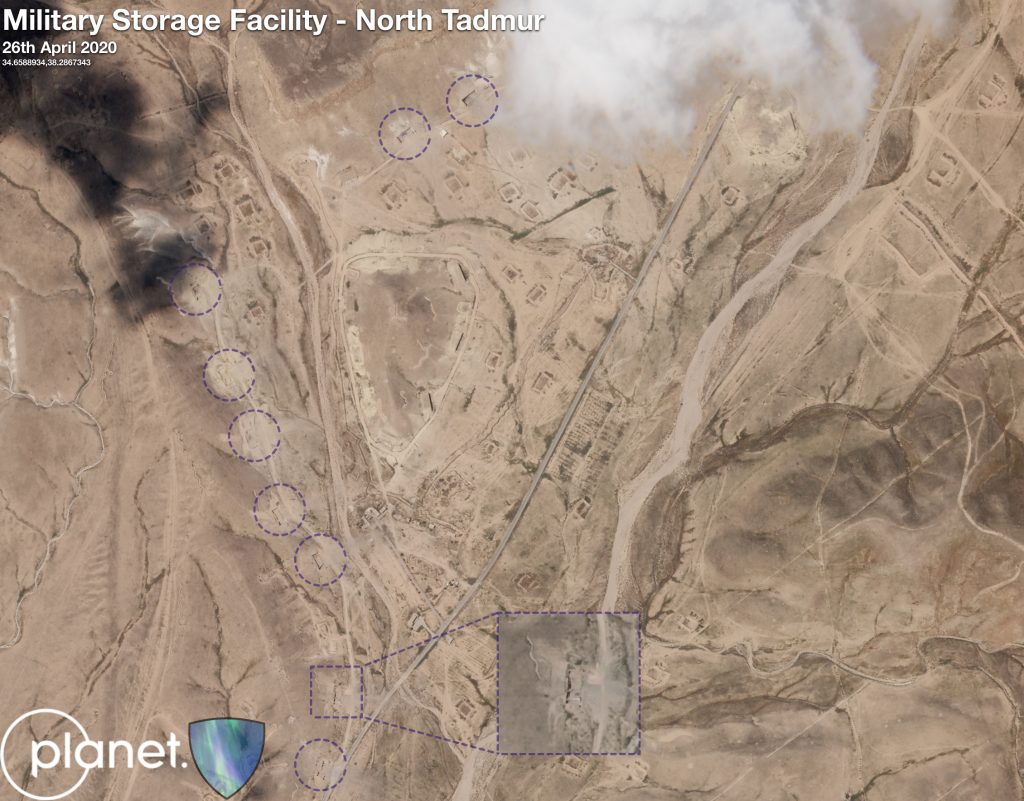Over recent weeks, Israel has intensified its military operations against suspected Iran-backed militia positions in Syria. Airstrikes against areas in southern and central Syria were reported on an almost weekly basis from the end of March through the end of April.
The latest round of airstrikes started March 31 when Israel Defense Forces’ (IDF) jets purportedly struck the Shayrat airbase located 15 miles southeast of the city of Homs. Post-strike satellite imagery of the airbase revealed the base’s runways were targeted in the attack. It is believed the intent was to temporarily disrupt Iran’s weapons transfer operation at the airbase.
As previously detailed in FDD’s Long War Journal, two weeks after the Shayrat strike, a missile struck a Jeep in the Syrian town of Jdaidit Yabws, near the Lebanese border. It is suspected the vehicle carried precision guided missile components from Iran intended for Hezbollah in Lebanon.
On April 20, Syria’s state-run news agency (SANA) reported Syrian air defense units opened fire and shot down several missiles launched by Israeli warplanes near Palmyra. Additionally, satellite imagery suggests the airstrikes were successful in destroying warehouses that may have contained missiles or advanced weapons.
A week after the airstrikes in central Syria, the Mezzah military airport near Damascus came under attack. Analysis of satellite imagery indicated a section of the airport suspected of being an underground Islamic Republican Guard Corps (IRGC) facility was attacked.
Furthermore, on the night of April 30, explosions were reported in Quneitra, located in southern Syria abutting the Golan. Syrian state-run media blamed the attack on Israel.
“Enemy Israeli helicopters attacked with several missiles from the airspace of the occupied Syrian-Golan against locations in the southern region and material damage was limited,” read the statement from SANA.
Israel’s role in the conflict
The IDF has operated against Iran and its proxy militias in Syria for the better half of the last decade. The conflict intensified when Hezbollah and other Iran-backed groups started military operations near the Golan Heights.
As fighting between Syria’s allies, anti-government rebels and ISIS flared-up along the Golan during the civil war, spillover from fighting on the Syrian side triggered Israeli retaliation.
In a documented example, Liwa Fatemiyoun (Iran-backed Afghan militia) claimed the IDF targeted their position as it conducted an anti-ISIS operation near the Golan.
It is also noteworthy that the IDF conducted operations against Hezbollah during the civil war. Senior members such as Jihad Mughniyeh (son of Imad Mughniyeh) and Samir Kuntar, were killed by IDF airstrikes as they operated in Syrian territory.
After the Syrian government and its allies successfully reclaimed territories it lost in southern Syria, Israel adjusted its strategy. It was forced to step up its efforts of denying Iran the transfer of advanced weapons to its proxies. Israel also had to thwart the attempt to turn the Israel-Syrian border into a front for Iran-backed militias, as Iran had successfully done in Lebanon with Hezbollah.
Military pressure has not deterred Iran
Iran has not been discouraged from achieving its goals in Syria. Years of advanced weapons transfers followed by Israeli airstrikes and attacks along the Syrian-Golan bolsters this assessment.
Undeterred by Iran’s activity in Syria, Israel’s government remains confident that it will succeed in removing Iran from Syria.
“We have moved on from blocking Iran’s entrenchment in Syria to muscling it out of there, and we shall not stop. We won’t allow further strategic threats to sprout just across our borders without taking decisive action,” Israel’s outgoing Defense Minister Naftali Bennett stated April 28.
It is unlikely Israel will be able to remove Iran from Syria by airstrikes alone. Iran has entrenched itself in Syria having heavily invested in its government financially and militarily.
For Israel’s objective of removing Iran and its proxies from Syria to be achieved, Iran must be forced to believe that its military interests in Syria are outweighed by its cost. This is why the effort, primarily led by the U.S. of imposing sanctions on Iran is important to Israel. The effect of sanctions including Israeli military action in Syria could lead Iran to rethink its current strategy.
Israel will continue its military operations as long it views Iran as a threat in Syria. The two foes have seemingly reached a point of inevitable wide-scale conflict.
It is the assessment of FDD’s Long War Journal that if both sides continue their current military strategies, the risk of a breakout of conflict between Iran, its Shiite proxies and Israel is substantial.
Are you a dedicated reader of FDD's Long War Journal? Has our research benefitted you or your team over the years? Support our independent reporting and analysis today by considering a one-time or monthly donation. Thanks for reading! You can make a tax-deductible donation here.
from Long War Journal – FDD's Long War Journal https://ift.tt/2WtL1l6
via Defense News

No comments: